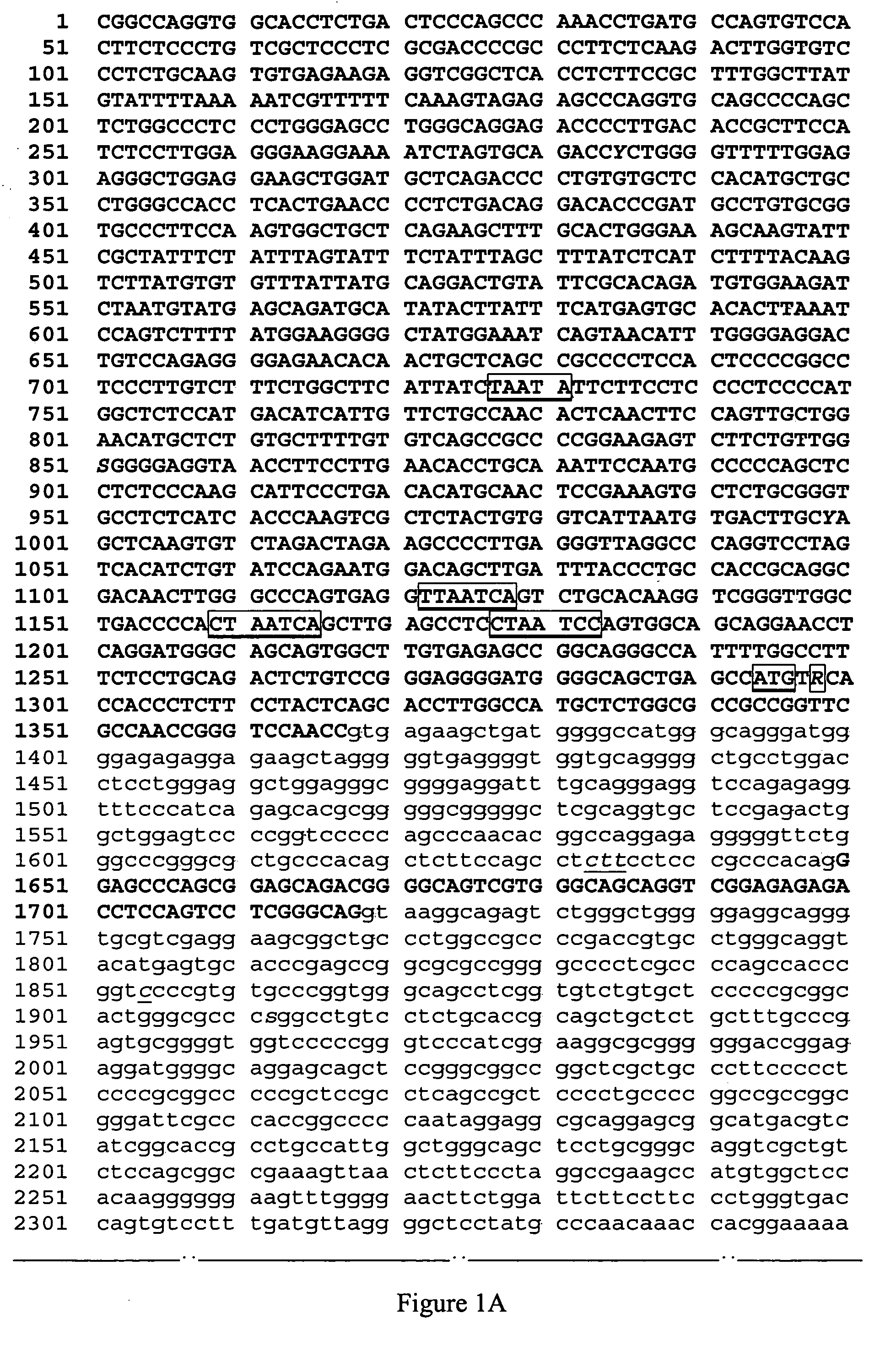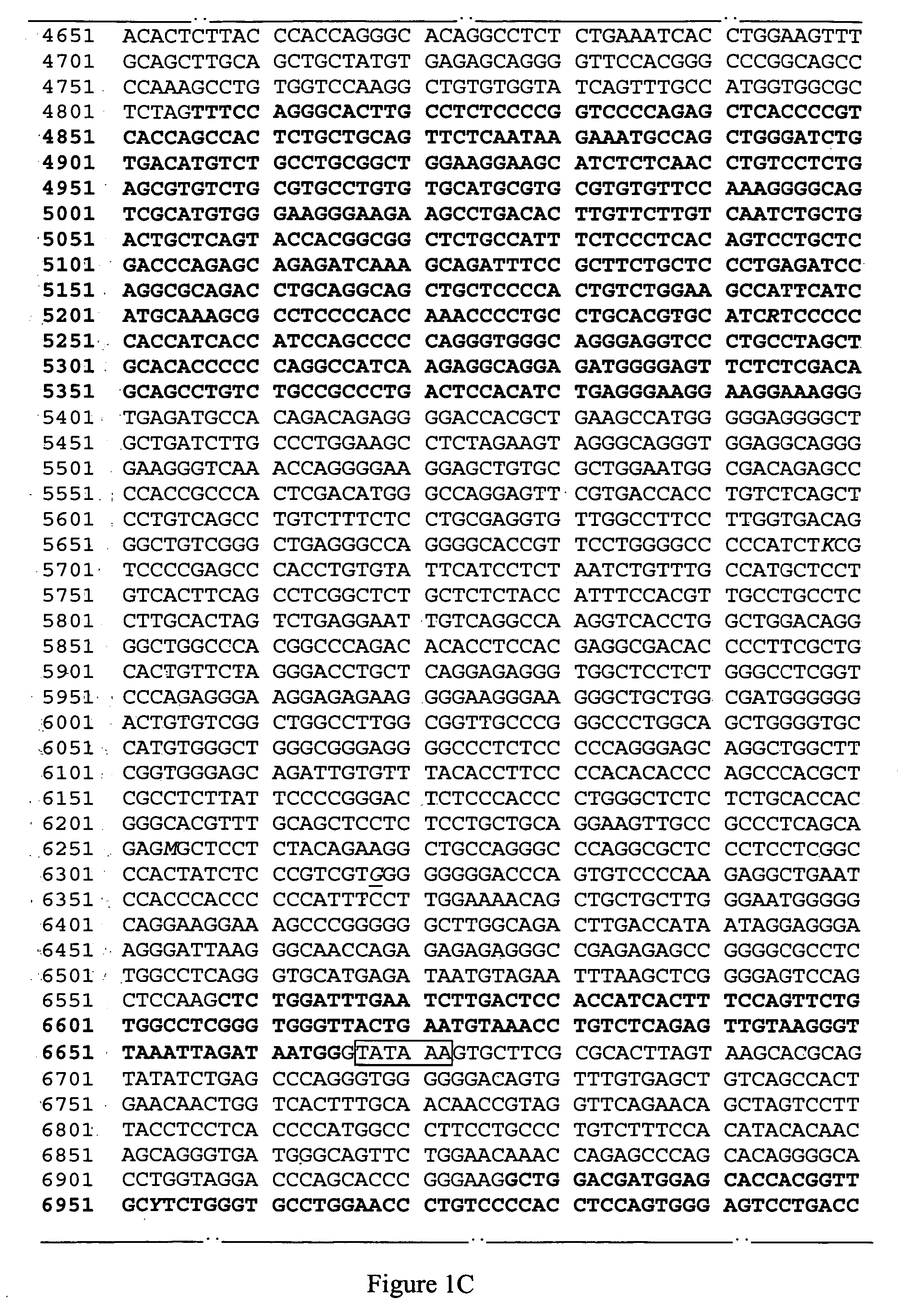Identification of the gene and mutation for progressive rod-cone degeneration in dog and a method for testing same
a technology of progressive rodcone degeneration and gene and mutation, applied in the field of gene and disease, can solve the problems of complicated clinical diagnosis of prcd disease, inability to reduce the frequency of prcd, and increase in disease frequency
- Summary
- Abstract
- Description
- Claims
- Application Information
AI Technical Summary
Problems solved by technology
Method used
Image
Examples
example 1
[0055] We have produced a retina specific canine EST library from 16 week old beagles. One set of 5 individual overlapping EST clones formed a contig which mapped to the previously specified CFA9 area (Sidjanin et al., 2003) and was therefore further investigated. This sequence contained the later defined F04 exon 8 (see below, EST clone contig, 1085 bp).
[0056] From sequence information from the above EST contig, and that of hypothetical human genes located within the corresponding region of the human genome sequence as deposited in GenBank, two primers were designed for RT-PCR: Forward: 5′-caccttggccatgctctggc-3′ (located at the end of exon 1)—SEQ ID-NO:4 Reverse: 5-aatgcatataaataaagcacttggc-3′ (located in exon 8)—SEQ ID NO:5
[0057] RT-PCR was performed from a 3.3 week normal dog resulting in a 707 bp product (clone 9) spanning the end of exon 1, exon 2, exon 3, exon 4 and exon 8.
[0058] Comparative in silico analysis of canine genomic sequence from our BAC contig (see example 2, ...
example 2
[0080] Since mapping the prcd locus to canine chromosome 9 (CFA9), we have mapped the prcd disease interval at higher resolution, narrowed the identified canine genomic region in which the prcd gene is located, and tested all candidate genes within that region. Initially, we created a physical map of the region using canine BACs (Sidjanin, 2003), and identified multiple polymorphic markers within and flanking this region. Examination of genotypes of prcd-affected dogs from multiple breeds for these polymorphic markers established that within breeds the haplotype that cosegregated with the prcd mutation extended across a broad region, including the physically mapped interval (Sidjanin et al., 2003). However, comparison of these genotypes revealed that the breed specific haplotypes varied among breeds within the area initially published (Sidjanin et al., 2003), but was consistent for all breeds for a set of markers physically located within a single BAC clone (BAC #10M13; Li et al, 19...
example 3
[0082] This example describes a PCR-based restriction enzyme digestion test developed to identify the sequence change in the F04 gene. The following primers were used:
primer 1: ccagtggcagcaggaacc -SEQ ID NO:27primer 2: ccgacctgctgcccacgactg -SEQ ID NO:28
PCR is run under standard conditions (annealing temp 58 degree C., 1.5 MgCl2) in 25 microliters, 35 cycles. The amplification product is 512 bp in size (corresponding to bp 1182 to 1693 in SEQ ID NO: 1. The restriction enzyme RsaI digests the amplification product bearing the A allele, but not the G allele. Conversely, ApaLI digests the G allele but not the A allele. Both digests were performed at 37° C. for 2 hours.
[0083] Restriction digestion thus yields the diagnostic results shown in Table 2:
TABLE 2ENZYME(restriction site)ALLELEFRAGMENT SIZE(S) (bp)RsaI (GT|AC)G512A116; 396ApaLI (G|TGCAC)G115; 397A512
[0084] A large population of dogs affected with prcd was examined. We have tested more than 100 affected animals from 13 diff...
PUM
| Property | Measurement | Unit |
|---|---|---|
| Biological properties | aaaaa | aaaaa |
Abstract
Description
Claims
Application Information
 Login to View More
Login to View More - R&D
- Intellectual Property
- Life Sciences
- Materials
- Tech Scout
- Unparalleled Data Quality
- Higher Quality Content
- 60% Fewer Hallucinations
Browse by: Latest US Patents, China's latest patents, Technical Efficacy Thesaurus, Application Domain, Technology Topic, Popular Technical Reports.
© 2025 PatSnap. All rights reserved.Legal|Privacy policy|Modern Slavery Act Transparency Statement|Sitemap|About US| Contact US: help@patsnap.com



